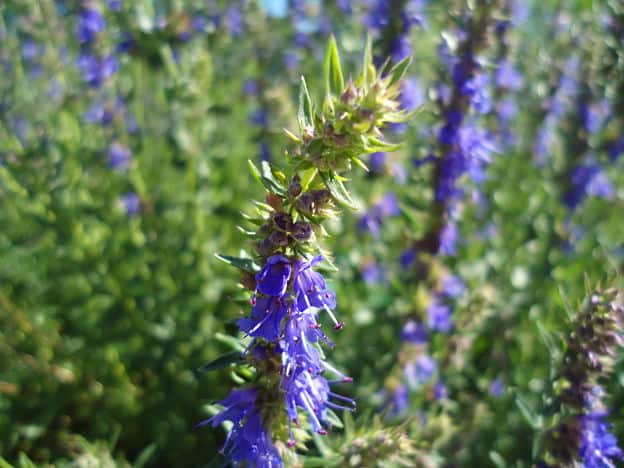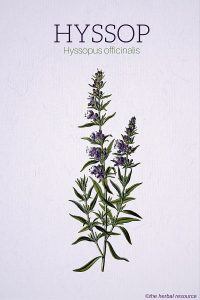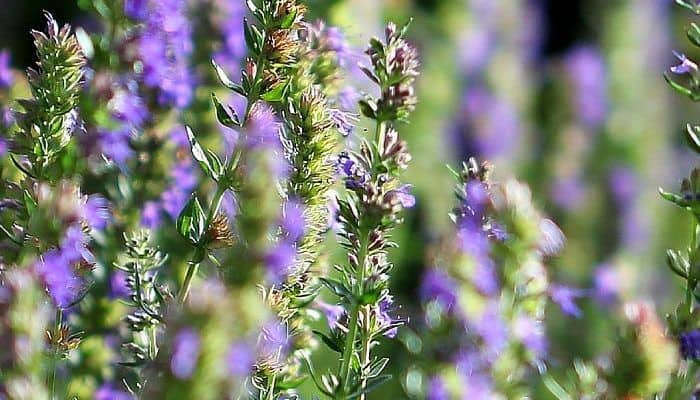Botanical Name: Hyssopus officinalis.
Other Common Names: Curdukotu, hastipippili, hisopo, yanagi-hakka.
Habitat: Hyssop is native to the Mediterranean countries and temperate parts of Asia but is now widely cultivated all over the world and often used as a decorative plant.
Plant Description: Hyssop is a perennial plant from the family of Lamiaceae or the mint family. This family contains a wide variety of medicinal and kitchen herbs.
Other well-known plants in this family are for example peppermint, basil, sage, lavender, thyme, and catnip.
Like all members of the mint family, hyssop has a slender, square stem with opposite positioned leaves and can reach heights of up to two feet.
Hyssop flowers from June through October with purple-blue colored flowers that are very fragrant and attract nectar-drinking insects. Some cultivars have white or pink-colored flowers.
Hyssop leaves and green stems contain many bioactive compounds like rosmarinic and caffeic acids along with pinanones, beta-pinene, limonene, pinocamphone, and isopinocamphone, tannin, glycosides (diosmine), flavonoids, and marrubin.
Many of these compounds are found in the volatile oil that can be produced in pure form by steam distillation of the crushed leaves and stems.
Plant Parts Used: The above-ground portion of the hyssop plant.

Therapeutic Uses, Benefits and Claims of Hyssop
Hyssop has been used for cleansing ritual and as medicine since biblical times. Today, it is known that the volatile oil and other ingredients that are contained in the leaves and green stems indeed have antibacterial, antiviral and other beneficial properties.
The infusion or decoction is being used to bring relief for the symptoms of lung and upper respiratory problems like the common cold, bronchitis, catarrh, and asthma, as it is antispasmodic, sweat-inducing and an expectorant (helps with the coughing up of mucus).
It can also bring relief in these conditions by preparing a poultice that is placed directly on the chest or through applying of Hyssop-oil containing ointment.
As a peripheral vasodilator, it is also diaphoretic (induces sweating) and has anti-inflammatory properties. The latter effect is used to naturally treat infections of the upper respiratory tract by inhaling vapors from hyssop decoctions.
The herb’s sweat-inducing properties may relieve the symptoms in patients with fever.
Poultices can help in the treatment of conjunctivitis and as a natural remedy for bruises, insect bites, and muscle pain.
Hot decoction vapors are also used as a natural remedy for tinnitus. Prepared as an infusion, hyssop can be used as natural treatment for colic, abdominal cramps, as a stimulant, to eliminate flatulence and to help with upset stomach.
Since hyssop works as a diuretic (increase the urine output) it can help flush out excess sodium from the body and therefore lower the blood pressure.
Less known uses of the infusion or the decoction made from hyssop are the stimulation of menstruation and relief of premenstrual syndrome symptoms, and the treatment of helminthic infections (infections with round- and tapeworms).
It can also have a calming effect on patients who suffer from anxiety and nervousness.
Dosage and Administration
Hyssop leaves can be prepared for medicinal use as infusion, decoction, or poultice. The [easyazon_link identifier=”B004752C4Q” locale=”US” tag=”herbal-resource-20″]commercially available oil[/easyazon_link] can be used internally after dilution or in ointments for external use.
For an infusion 1 tsp. dried herbs should be steeped in 1/2 cup water. Over the course of the day 1/2 to 1 1/2 cups should be taken, a mouthful at a time.
For a decoction, 1 tsp. herb should be boiled with 1 cup water. The usual dose is 1 to 2 cups per day.
To prepare a poultice, the fresh or dried herb should be soaked in a small amount of boiling water for 15 minutes and place on a cloth for application.
The crushed fresh leaves, if available, can also be applied directly to the skin for similar effects.
Side Effects and Possible Interactions of Hyssop
The essential oil contains pino-camphone. This ketone can cause convulsions and seizures when taken in high doses.
It is therefore not advisable to take hyssop oil and other hyssop preparations internally in high doses or over a longer time than two weeks.
As with all natural products allergies can develop. Since these can potentially be life-threatening, a doctor should be consulted immediately, if symptoms like skin rashes, swelling of skin or tongue, difficulty breathing, and/or tightness in the chest develop after the use of hyssop preparations.
Thordur Sturluson
Latest posts by Thordur Sturluson (see all)
- What is the Difference Between Hemp and Marijuana? - June 3, 2019


Leave a Reply